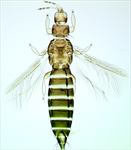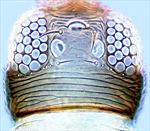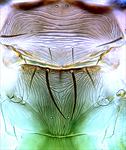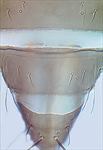
Female

Head

Antenna

Pronotum, mesonotum & metanotum

Mesonotum & metantoum

Tergites VII–IX

Sternites V–VII

Fore wing clavus

Fore wing
Female macropterous; body colour brown, legs yellowish, antennal segment III yellow; fore wing brown with base paler. Antennae 7-segmented (rarely with 8 segments), III & IV each slightly constricted at apex with short forked sense cone; segment VII short. Head wider than long, with 2 pairs of ocellar setae; pair III stout and arising just outside anterior margins of ocellar triangle; postocular setae pairs I & III shorter than ocellar setae pair III, pair II very small. Pronotum with 2 pairs of long posteroangular setae, posterior margin with 3 pairs of setae. Mesonotum with no lines of sculpture around anterior campaniform sensilla. Metanotum with lines of sculpture longitudinal medially, but transverse at anterior; median setae arising at anterior margin, campaniform sensilla present. Fore wing first vein with 3 setae on distal half, second vein with about 14 closely set setae; clavus with 5 marginal setae and subapical seta longer than apical seta. Tergite II with 4 lateral marginal setae; tergites V–VIII with ctenidia present laterally, on VIII posteromesad to spiracles; posterior margin of VIII with comb complete medially but microtrichia small and irregular and sometimes arising in groups; pleurotergites without discal setae. Sternite II with 2 pairs of marginal setae, III–VII with 3 pairs, median pair on VII arising in front of margin; sternite II with 1 to 4 discal setae, III–VII with discal setae varying in number from 6 to 14 in a regular transverse row.
Male similar to female in structure, but smaller and paler; tergite VIII with no marginal comb; tergite IX with median S1 setae longer than S2 and arising closer to S2 than to each other; sternites III–VII with transverse pore plate anterior to row of about 8 discal setae.
Although very similar to T. hawaiiensis, adults of T. florum have the the fore wing clavus subapical seta longer than the apical seta, and the mesonotum has no lines of sculpture around the anterior pair of campaniform sensilla. However, individuals are sometimes found that are not easily assigned to either species. The genus Thrips is the second largest genus in the Thysanoptera, and currently includes, worldwide, about 295 species. All members of genus Thrips lack ocellar setae I on the head, and they all have ctenidia on tergite VIII posteromesad to the spiracles. Other characters, such as number of antennal segments, number of setae on the fore wing veins, and number of discal setae on the sternites are variable between species (Palmer, 1992; Nakahara, 1994; Mound & Masumoto, 2005).
Apparently highly polyphagous, adults have been taken in the flowers of many plants.
Widespread across Asia from India to the Pacific, Fiji, Tahiti, and eastern Australia; presumably introduced in Florida, the West Indies, Costa Rica and Guatemala, and likely to be introduced to California through the horticultural trade.
THRIPIDAE - THRIPINAE
Thrips florum Schmutz
Thrips florum Schmutz, 1913: 1003
Thrips parvus Schmutz, 1913: 1004
Thrips magnipes Schmutz, 1913: 1006
Thrips rhodamniae Schmutz, 1913: 1008
Thrips pallida Schmutz, 1913: 1015
Thrips peradenyae Schmutz, 1913: 1015
Thrips darci Girault, 1930: 1
Thrips exilicornis Hood, 1932: 129
Thrips dunbariae Priesner, 1934: 261.
Mound LA & Masumoto M (2005) The genus Thrips (Thysanoptera, Thripidae) in Australia, New Caledonia and New Zealand. Zootaxa 1020: 1–64.
Nakahara S (1994) The genus Thrips Linnaeus (Thysanoptera: Thripidae) of the New World. United States Department of Agriculture. Technical Bulletin 1822: 1–183.
Palmer JM (1992) Thrips (Thysanoptera) from Pakistan to the Pacific: a review. Bulletin of the British Museum (Natural History) Entomology Series 61 (1): 1–76.